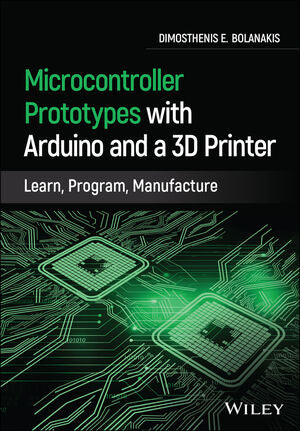Customer Feature: Author in Engineering Education, Dr. Dimosthenis Bolanakis

Dr. Dimosthenis Bolanakis of Greece uses the TinyCircuits TinyDuino and Wireling Platform in his newly available novel Microcontroller Prototypes with Arduino and a 3D Printer: Learn, Program, Manufacture | Wiley.
Dr. Bolanakis has long been interested in Microcontrollers, and has published journal papers dating back to 2007, such as "An Integrated Microcontroller-based Tutoring System for a Computer Architecture Laboratory Course” and “A Survey of Research in Microcontroller Education” on the topic of Microcontrollers in education. Additionally, he has previously published an instructional novel on the M68HC908GP32 in 2012. In the last few decades, many incredible advancements in technology have been made, as well as wider interest in the Microcontroller area thanks to commercial Microcontroller products like the Arduino. Dimos said in this new age he "felt the need to share his perspective on the process of implementing Microcontroller prototypes in the Maker era."
His newest novel focuses on the Arduino platform, which led Dr. Bolanakis to our tiny, Arduino compatible boards. After experiencing the stackable nature of our boards, he chose to include them in his novel, saying:
"The motivation for incorporating TinyCircuits’ hardware relies on the way boards are attached to each other. Compared to the standard 2.54 pin-header commonly used by microcontroller products addressed for makers, the surface-mount technology (SMT) board-to-board connector of really low profile eliminates the useless space between the stackable boards. To save space with the 2.54 pin-header technology one should solder directly the boards to each other, while the SMT connector used by TinyCircuits not only minimizes space between the stackable boards, but also allows us to detach the boards (without applying any de-soldering re-works) whenever we like. The latter option is (in my opinion) very important for hobbyists."
Dimos demonstrates how to craft creative and innovative solutions in embedded systems design by providing practical and illustrative methods and examples, including a 1D gesture recognition program reliant on the Time-of-Flight Distance Sensor Wireling that uses just a few lines of code.

To see what other Arduino compatible hardware and 3D printing technology is used in the book, checkout the companion site (https://mikroct.com/tools/) that lists all the software and hardware highlighted in Microcontroller Prototypes with Arduino and a 3D Printer: Learn, Program, Manufacture | Wiley.
Dr. Bolanakis hopes that with his newest novel in his growing collection of work on Microcontroller education that readers take away the building blocks of prototyping with Microcontollers
"I anticipate that the readers will build the solid background required to make the passage from ‘have knowledge of’ to ‘mastering’ the design of microcontroller-based projects and applications."

